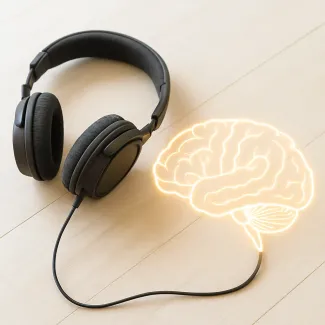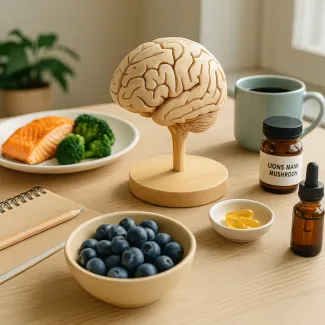
Unlocking the Mind Through Sound: How Binaural Audio Enhances Inner Peace
A deeper look into the neurological effects of binaural beats and how to incorporate them into daily wellness
Binaural beats have entered the spotlight as a non-invasive, drug-free method to promote mental clarity, emotional balance, and profound relaxation. While the concept may sound technical, it’s rooted in a surprisingly simple auditory phenomenon. When two slightly different frequencies are played in each ear, the brain perceives a third frequency—known as a binaural beat—which can influence mental states. Depending on the frequency difference, these beats can encourage deep relaxation, enhanced focus, or even meditative awareness.
Understanding how these sounds affect the brain requires more than passive listening. The brainwave entrainment process can lead to noticeable shifts in cognitive and emotional states. By learning how and when to use these audio tools, individuals can unlock the brain's ability to self-regulate, rejuvenate, and even reprogram mental patterns that are deeply rooted in stress or anxiety.
What happens in your brain during binaural beat exposure?
To understand why binaural beats are effective, it's essential to grasp how brainwaves function. Our brain produces different types of electrical patterns, known as brainwaves, which correspond to various states of consciousness. These include:
- Delta waves (0.5–4 Hz), linked to deep sleep and unconscious states
- Theta waves (4–8 Hz), associated with light sleep and deep meditation
- Alpha waves (8–14 Hz), which occur during calm, reflective moments
- Beta waves (14–30 Hz), connected with active thinking and concentration
- Gamma waves (above 30 Hz), related to high-level cognition and insight
When a person listens to binaural beats that target a specific range, the brain begins to mirror the frequency. For example, if the goal is stress reduction, listening to audio that generates theta or alpha wave activity may bring the brain into a state that promotes relaxation and mindfulness.
Different frequencies for different goals
Each binaural frequency range has specific benefits. It's not a one-size-fits-all approach. Choosing the right beat depends on the mental or emotional state you want to cultivate:
- For better sleep or nap sessions, delta frequencies are ideal.
- For creative thinking, theta frequencies promote imaginative flow.
- For relaxation and reduced anxiety, alpha beats are beneficial.
- For study and productivity, beta waves help sustain attention.
- For peak concentration, gamma beats can sharpen the mind.
Listening to a 10 Hz binaural beat (within the alpha range) might create a mild meditative state, making it perfect for winding down after a busy day. Conversely, a 16 Hz beat (beta) can prepare the mind for mentally demanding tasks.
How to use binaural beats for daily relaxation
The beauty of binaural beats is their simplicity. All that’s required are headphones and a quiet environment. Since each ear needs to receive a distinct frequency, stereo headphones are essential. A 20-minute session can be enough to lower cortisol levels, soothe a racing mind, and induce mental clarity.
Some users incorporate these beats into their morning rituals, using alpha waves to ease into the day without the jolt of caffeine. Others turn to theta frequencies during evening wind-down routines, encouraging mental decompression after a demanding workday.
Integrating binaural beats into a meditation practice can also enhance the experience, helping the mind drop into deeper levels of stillness. Even passive listening during activities such as journaling or stretching can yield a measurable shift in emotional calm.
Binaural beats vs. white noise and nature sounds
It's important to differentiate binaural beats from other audio tools like white noise, pink noise, or nature sounds. While white noise can mask distractions, it doesn't engage the brain's electrical patterns in the same way. Nature sounds are great for ambiance, but they don't create the neural resonance triggered by true binaural stimuli.
That said, many high-quality recordings combine ambient nature tones with binaural beats, delivering a dual benefit: soothing natural environments paired with the neurological stimulation of frequency-based entrainment.
Creating the ideal sound environment
To get the most from binaural therapy, your physical environment matters. A clutter-free space helps minimize external distractions. Dim lighting or a sleep mask can enhance internal focus. Some people find it helpful to lie down with eyes closed, allowing the body to enter a parasympathetic state while the mind tunes into the soundscape.
Avoid multitasking during your sessions. While binaural beats can enhance focus, their core power lies in their ability to shift brainwave states, which is best experienced when the mind is not split between competing tasks.
How long and how often should you listen?
Consistency is more important than duration. A daily session of 15–30 minutes is enough to create lasting change in mental patterns. Many users report improvements in sleep quality, reduced stress, and better cognitive performance within a few days of regular use.
For long-term mental wellness, integrating these sessions into your lifestyle rhythms—such as a morning meditation or evening wind-down—ensures that the brain becomes accustomed to functioning in healthier frequency ranges.
Common mistakes and how to avoid them
One of the most common errors is listening to binaural beats without stereo headphones, which makes the beats ineffective. Another mistake is playing them in the background while focusing on work that requires attention to other audio, like meetings or podcasts. For maximum benefit, treat your listening session as dedicated brain training time.
Additionally, trying to multitask emotional healing can backfire. Avoid combining binaural beats with emotionally intense content, such as news or social media. The goal is to create neurological space, not add more layers of stimulation.
Applications beyond relaxation: performance and recovery
Binaural beats aren’t only for calm. Athletes and high performers use beta and gamma frequencies to optimize reaction time, mental sharpness, and flow states. For instance, before public speaking or creative projects, a session of high-frequency beats can help prime the brain for performance.
Similarly, those recovering from emotional burnout or chronic fatigue may find low-frequency beats helpful in retraining the nervous system. Over time, consistent use helps downregulate the stress response, offering a natural path to equilibrium.
Mental health and emotional balance
Individuals with anxiety, overwhelm, or racing thoughts often struggle to access traditional meditative states. For these individuals, binaural therapy offers a shortcut—a sound-induced bridge to calm. While not a replacement for professional care, this tool serves as an accessible and empowering practice that promotes self-regulation.
The beats can act as an anchor when the mind becomes untethered, helping to establish new mental habits rooted in stillness and control. Regular use helps build a foundation for emotional balance, which often spills over into improved relationships, productivity, and self-esteem.
Nighttime listening and improved sleep
Many people suffer from sleep disturbances rooted in overstimulation. From blue light to evening worries, the brain rarely has a chance to power down naturally. Listening to delta frequencies 30 minutes before bed can act as a powerful cue for the brain to begin slowing its rhythm, preparing for a deeper, more restorative sleep cycle.
Some prefer to keep low-frequency beats playing through the night. While the effectiveness of overnight use varies, many report fewer awakenings, longer REM cycles, and feeling more refreshed upon waking.
Choosing the right recordings
Not all binaural audio is created equal. When selecting tracks, look for clearly labeled frequencies, preferably with information about the intended outcome (e.g., “theta waves for creativity”). Professional recordings often specify carrier frequencies and ensure smooth transitions between tones.
Avoid tracks with distracting voiceovers, unless the intention is guided meditation. For pure frequency entrainment, minimalistic soundscapes without abrupt changes are most effective. High‑quality audio ensures a consistent experience, free from artifacts that can break the trance-like state.
Can children and older adults use binaural beats?
Yes—but with care. For children, shorter sessions (5–10 minutes) of alpha or theta frequencies can support calmness or focus, especially when paired with quiet activities like reading. However, they should not use beats intended for sleep or deep meditation without supervision.
For older adults, binaural beats may assist with cognitive maintenance, stress reduction, and even mild sleep issues. As with any new intervention, it's best to start slowly and monitor how the individual responds.
The connection between sound and neuroplasticity
One of the most fascinating benefits of binaural audio is its role in supporting neuroplasticity—the brain’s ability to reorganize itself. By training the brain to operate in different frequency states, individuals can rewire habits, reduce reactivity, and increase cognitive flexibility.
For example, those prone to overthinking might benefit from theta or alpha frequencies that lower the dominance of beta wave activity. Over time, the brain becomes more adept at accessing these states independently, even without audio support.
Combining binaural therapy with other wellness tools
The synergy between binaural beats and breathwork, yoga, or mindful walking creates a holistic experience. For example, pairing box breathing with alpha wave audio can amplify calm and presence. Combining theta beats with slow stretching or restorative yoga enhances the body’s parasympathetic response.
Even aromatherapy can deepen the effect. Scents like lavender or frankincense, combined with low-frequency audio, enhance the brain’s shift into calm.
Using beats to manage digital burnout
In a world of constant notifications and fragmented attention, digital burnout is real. Binaural beats offer a brief but potent escape. A 15-minute mid-afternoon session can reset attention spans and refresh mental stamina.
Consider it a digital detox you can do at your desk. Unlike scrolling or watching videos, this form of rest doesn’t add input—it gently shifts internal states, allowing the nervous system to breathe.
How binaural beats support emotional processing
Beyond surface-level relaxation, binaural beats can assist in processing repressed or unresolved emotions. In meditative states induced by theta or delta waves, the subconscious becomes more accessible, allowing buried thoughts or patterns to emerge.
This process can be supported with journaling, visualization, or simply being present with emerging feelings. Over time, these sessions help clear emotional stagnation, leaving space for resilience and renewal.
When to avoid or limit use
Though generally safe, binaural beats should be used mindfully. Those with a history of epilepsy or auditory sensitivity should consult a healthcare provider before use. Additionally, avoid use while driving or operating heavy machinery.
It’s also wise to avoid high-frequency beats late in the evening, as beta or gamma ranges can be stimulating. Always match the frequency to the desired state, and when in doubt, start with lower ranges.
Building your own playlist
Creating a personal binaural library can enhance your wellness routine. Consider organizing tracks by desired effect: one playlist for sleep, one for focus, another for emotional grounding.
Include different lengths, from quick 5-minute resets to immersive 45-minute sessions. Label them intuitively, so you can choose the right track without thinking—let the sound guide you back to yourself.





